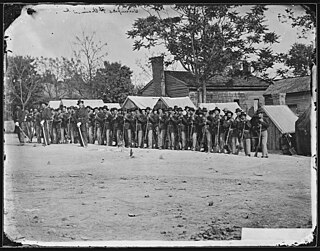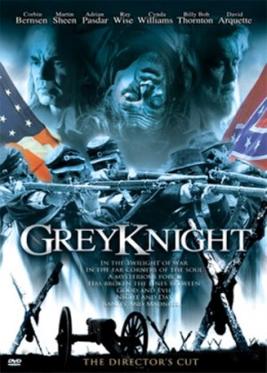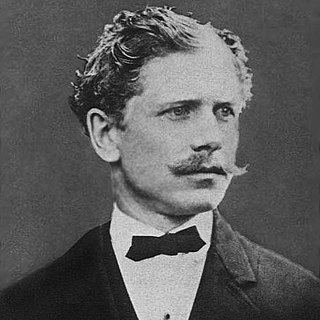
"An Occurrence at Owl Creek Bridge" (1890) is a short story by the American writer and Civil War veteran Ambrose Bierce. Described as "one of the most famous and frequently anthologized stories in American literature", it was originally published by The San Francisco Examiner on July 13, 1890, and was first collected in Bierce's book Tales of Soldiers and Civilians (1891). The story, which is set during the American Civil War, is known for its irregular time sequence and twist ending. Bierce's abandonment of strict linear narration in favor of the internal mind of the protagonist is an early example of the stream of consciousness narrative mode.
"An Inhabitant of Carcosa" is a short story by American Civil War veteran, wit, and writer Ambrose Bierce. It was first published in the San Francisco Newsletter of December 25, 1886 and was later reprinted as part of Bierce's collections Tales of Soldiers and Civilians and Can Such Things Be?

The 9th Indiana Volunteer Infantry Regiment was a volunteer infantry regiment in the Union Army during the American Civil War. It was organized on April 22, 1861, for three-months' service in Indianapolis. After being reorganized for three years' service in late August and early September 1861, the 9th took part in many major battles, including Shiloh, Stones River, Chickamauga, Lookout Mountain, Missionary Ridge, Kennesaw Mountain and the Siege of Atlanta.

Ghost Brigade is a 1993 American supernatural horror film set during the American Civil War and directed by George Hickenlooper. Starring Corbin Bernsen, Adrian Pasdar, and Martin Sheen, the film was also released under the alternate titles The Killing Box, Grey Knight, and The Lost Brigade.
"A Horseman in the Sky" is a heavily anthologized short story by American Civil War soldier, wit, and writer Ambrose Bierce. It was published on April 14, 1889 under the title The Horseman in the Sky in the Sunday edition of The Examiner, a San Francisco newspaper owned by William Randolph Hearst. It is set during the American Civil War and is one of Bierce's best known war stories. Bierce revised the story for his book Tales of Soldiers and Civilians.

Ambrose Gwinnett Bierce was an American short story writer, journalist, poet, and American Civil War veteran. His book The Devil's Dictionary was named one of "The 100 Greatest Masterpieces of American Literature" by the American Revolution Bicentennial Administration. His story "An Occurrence at Owl Creek Bridge" has been described as "one of the most famous and frequently anthologized stories in American literature", and his book Tales of Soldiers and Civilians was named by the Grolier Club one of the 100 most influential American books printed before 1900.
"The Damned Thing" is a horror short story written by American Civil War soldier, wit, and writer Ambrose Bierce. It first appeared in Town Topics on December 7, 1893.

Tales of Soldiers and Civilians is a collection of short stories by American Civil War soldier, wit, and writer Ambrose Bierce, also published under the title In the Midst of Life. With a stated publication date of 1891 the stories describe unusual incidents in the lives of soldiers and civilians during the American Civil War. Tales of Soldiers and Civilians was named by the Grolier Club as one of the 100 most influential American books printed before 1900, stating "These short stories are among the finest, and best known, in American literature. ... Written in a clear simple style, with each phrase contributing to the total effect, Bierce's tales pointed the way for the American short-story writer." Bierce's famous story "An Occurrence at Owl Creek Bridge" is included in this collection.
"The Moonlit Road" is a gothic horror short story by American Civil War soldier, wit, and writer Ambrose Bierce. It first appeared in a 1907 issue of Cosmopolitan magazine, illustrated by Charles B. Falls. This story is presented in three parts and relates the tale of the murder of Julia Hetman from the perspective of her son, a man who may be her husband, and Julia herself, through a medium.
"Killed at Resaca" is a short story by American Civil War soldier, wit, and writer Ambrose Bierce. First published in The San Francisco Examiner on June 5, 1887, it was later included in Bierce's Tales of Soldiers and Civilians in 1891.
"The Man and the Snake" is a short story by American Civil War soldier, wit, and writer Ambrose Bierce. It tells of a man who dies of fright inspired by a toy snake with buttons for eyes. The story was published in The San Francisco Examiner on June 29, 1890.
"The Eyes of the Panther" is a short story by American Civil War soldier, wit, and writer Ambrose Bierce featuring a female werepanther. It was published in The San Francisco Examiner on 17 October, 1897 before appearing in his 1898 collection In the Midst of Life.
"The Boarded Window: An Incident in the Life of an Ohio Pioneer" is a short story by American Civil War soldier and writer Ambrose Bierce. It was first published in The San Francisco Examiner on April 12, 1891, and was reprinted the same year in Bierce's collection Tales of Soldiers and Civilians. The setting for the story is the part of Ohio where Bierce's family lived until 1846.
"The Middle Toe of the Right Foot" is a ghost story by American Civil War soldier, wit, and writer Ambrose Bierce. It was first published in The San Francisco Examiner on April 17, 1890, and was reprinted the following year as part of Tales of Soldiers and Civilians.
"One of Twins" is a short story by American Civil War soldier, wit, and writer Ambrose Bierce exploring a telepathic connection between the twins. It was first published in The San Francisco Examiner on October 28, 1888 and was included in Bierce's 1893 collection of supernatural tales Can Such Things Be?

"The Death of Halpin Frayser" is a Gothic ghost story by Ambrose Bierce. It was first published in the San Francisco periodical The Wave on December 19, 1891 before appearing in the 1893 collection Can Such Things Be?
"One of the Missing" is a short story by American Civil War soldier, wit, and writer Ambrose Bierce. It was first published in The San Francisco Examiner on March 11, 1888 and was reprinted in Tales of Soldiers and Civilians (1891).

"A Psychological Shipwreck" is a short story by American Civil War soldier, wit, and writer Ambrose Bierce and published by The Argonaut under the title "My Shipwreck" on May 24, 1879. It was included in the 1893 collection Can Such Things Be?

"The Realm of the Unreal" is a short story by American Civil War soldier, wit, and writer Ambrose Bierce. It appeared in The San Francisco Examiner on July 20, 1890 and was reprinted in the 1893 collection Can Such Things Be?

The Hazen Brigade Monument at Stones River National Battlefield, Murfreesboro, Tennessee, is the oldest American Civil War monument remaining in its original battlefield location.







